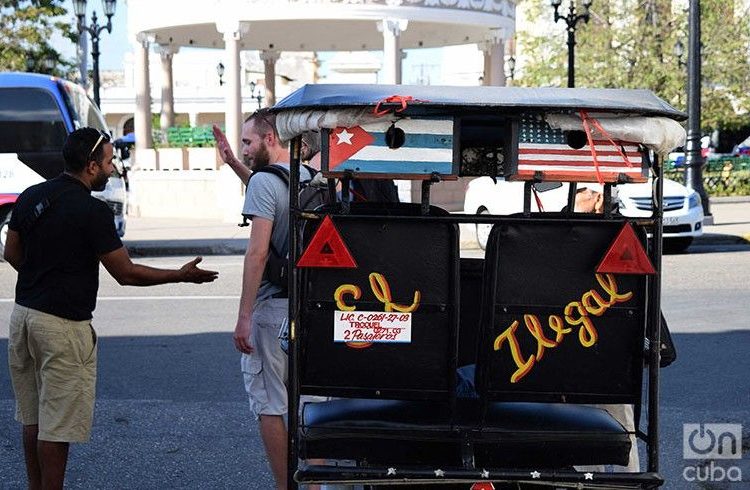The U.S. economic embargo cost Cuban tourism more than 1.7 billion dollars between April 2016 and June 2017. According to a report published in the state-run press, tourism is the sector most affected in this period because of the financial and commercial restrictions imposed on the island by the U.S. government.
The Cuban authorities estimate that if U.S. tourists could travel freely to Cuba, the island would collect 1.5 billion dollars a year with those visits. In addition, it would obtain 15 million for the mooring of yachts from the United States with an average stay of a week, as well as other incomes that would amount to almost 1.702 billion dollars now declared as losses.
After the thaw between the two countries announced in December 2014, the Obama administration relaxed some of his country’s sanctions against Cuba and approved 12 categories to make flexible the trips of U.S. citizens to the island for religious, cultural, educational, humanitarian aid reasons or personal exchange with the Cuban people, among others.
He also allowed the resumption of commercial flights and cruise trips to Cuba, after half a century of being suspended.
These measures brought about a notable increase of visitors from the United States: in 2016 285,000 Americans traveled to Cuba, while between January and May of this year 284,565 did so, according to official data.
The boost given to tourism on the island by these visits contributed to the record of four million visitors last year and to place the estimate for 2017 at 4.7 million.
However, the current president of the United States, Donald Trump, opposed to his predecessor’s policies toward Cuba, on June announced he would impose new restrictions to travel to the island and would veto individual visits, although they can still travel in groups.
According to the Cuban government, the embargo also caused serious damages in other economic and social sectors of the island, among them food (347,598,000), transportation (122,300,000) and the energy and mines sector (122,500,000).
Cuba’s official report registers in more than 68 million dollars the losses in communications and information technology, while industry and construction suffered damages worth 59 and 12 million dollars, respectively.
The island also denounced damages in sensitive spheres like public health (87,000,000), culture (35,314,000) and education (2,800,000), where the losses were associated mainly to expenses for the import of resources that on the island are offered free of charge or subsidized.
In addition, damages are reported to the biotechnological and pharmaceutical industry, which cannot acquire spare parts and equipment for its research.
Cuba estimates at 822.28 billion dollars the damages caused by the U.S. embargo, taking into account the depreciation of the dollar in the face of the value of gold on the international market. At current prices, the punitive measure has caused damages worth more than 130.178 billion dollars.
Just since April 2016 to June of this year, the embargo has added 4.305 billion dollars’ worth of losses to Cuba, double what the national economy needs for its development.
Foreign banks as well
In its report on the damages caused by the U.S. embargo, the Cuban government affirmed that that restrictive policy has hindered its financial operations with some 100 foreign banks, most of them in Europe, which closed accounts, retained funds and refused to provide services to the island between April 2016 and March of this year.
The ban on U.S. banks making transactions or doing financial business in the Caribbean country, extended to foreign financial entities, also caused that in that period 36 banks refused to arrange letters of credit, 27 returned operations and 19 refused their services for fear of sanctions from the United States.
Cuba has repeated denounced the “financial persecution” against third country banks operating with the island, on which the U.S. government has imposed fines worth millions of dollars in the last three years.
Neither does the United States allow Cuban banks to have correspondent accounts on U.S. territory, which makes the arrangements more costly and take longer.
The island’s authorities also affirm not being able to use the dollar in its transactions, despite the fact that in 2016 former President Barack Obama approved a measure that lifted the restriction on the use of that currency included in the embargo on Cuba since 1962.
The economic damages reported now by the Cuban government form part of the information campaign about the damages of the U.S. embargo which Cuba carries out every year before presenting a resolution of condemnation to the UN General Assembly. This resolution every year receives a majority backing by the international community.
In 2016 the text had 191 votes in favor with the abstention of the United States and Israel. It was the first time that Washington did not vote against the resolution, which has been presented at the UN every year since 1992.
The 2017 voting, previewed for November, will take place in the middle of the cooling of bilateral relations because of the mysterious “sonic attacks” allegedly suffered by more than 20 U.S. diplomats on the island and to which the Trump administration has responded by withdrawing two-thirds of its diplomatic personnel in Havana.
He has also expelled 15 officials from the Cuban embassy in Washington and has recommended that Americans not travel to the island.
However, U.S. agencies and companies linked to trips to Cuba have reiterated that no U.S. visitor has been affected by incidents of this type during their visits.
The U.S. government has not blamed anyone until now for the alleged “attacks,” but does make Havana responsible for not having complied with its obligation of guaranteeing the safety of the diplomats and their families on Cuban territory.
Meanwhile, Cuba denies having been involved in the incidents and considers that the decisions made by the United States in recent weeks are “hasty,” “unjustified” and due to political reasons.
EFE / OnCuba










